Iridoteuthis iris
Richard E. Young and Michael VecchioneIntroduction
Iridoteuthis iris is a small heteroteuthin (28 mm ML in females, 24 mm in males) with very large eyes, short mantle that projects ventrally anterior to the eye lenses and unusually large fins. It is known only from Hawaiian waters.
Brief diagnosis
An Iridoteuthis ...
- without elaborate ventral protective membrane on right arm I in mature males.
- with size differentials in some arm suckers between dorsal and ventral series in males.
- with bare, elongate sucker stalks on tips of arms III and IV in females.
Characteristics
- Arms (Harman and Seki, 1990)
- Males
- Arms I in males with dorsal series of suckers reduced in size on distal region of arms.
- Arms II in males each with slightly enlarged suckers on middle of arms.
- Arms III in males each with several greatly enlarged suckers in midarm of dorsal series; distal to enlarged suckers a short area without suckers and only sucker stalks (=pedicels).
- Arms IV ends in males each with suckers in four series.
- Enlarged dorsal keels (flags) at tips of arms I-III in males.
 Click on an image to view larger version & data in a new window
Click on an image to view larger version & data in a new window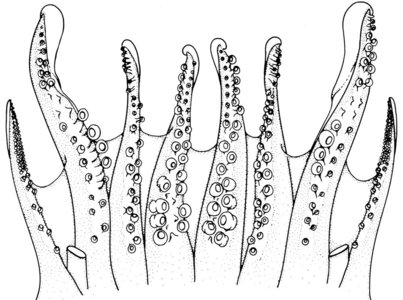
Figure. Oral view of the brachial crown of I. iris, male, 24 mm ML. Drawing from Harman and Seki (1990).
- Arms I in males with dorsal series of suckers reduced in size on distal region of arms.
- Females
- Tips of arms I in females bare.
- Distal region of each arm III with elongate trabeculae, no suckers.
- Distal region of each arm IV with elongate trabeculae, no suckers; proximal half with relatively large suckers; next quarter with smaller suckers in somewhat irregular series.
 Click on an image to view larger version & data in a new window
Click on an image to view larger version & data in a new window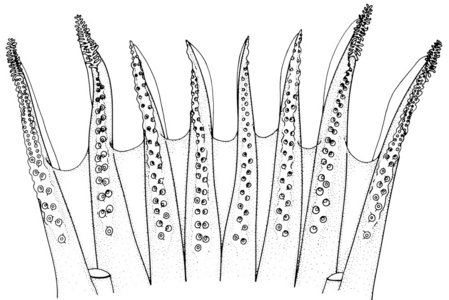
Figure. Oral view of the brachial crown of I. iris, female, 21 mm ML. Drawing from Harman and Seki (1990).
 Click on an image to view larger version & data in a new window
Click on an image to view larger version & data in a new window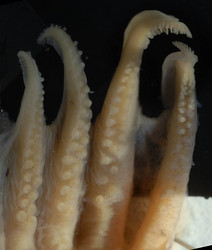
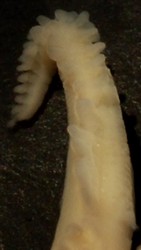
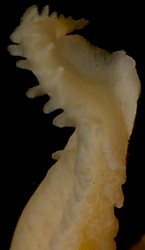
Figure. Oral views of the arms of I. iris, female. Specimen appears to be the same as that from which the drawing above was made. Left - Left arms I-IV with arm I on the left of the photograph. Middle - Arm III tip. Right - Arm IV tip. Photographs by R. Young.
- Males
Comments
More details of the description of I. iris can be found here.
Sexual dimorphism of arms apparent in animals larger than 8 mm ML (Harman and Seki, 1990).
See the Iridoteuthis page for a table comparing the most obvious differences between the species.
Distribution
Type locality: Off the south coast of Molokai Isl, Hawaiian Archipelago, central North Pacific from over a bottom depth of 280 m. Subsequently captured at a variety of localities along the Hawaiian Archipelago from about 21°N, 157°W to about 32°N, 177°E. All captures are close to islands or seamounts and are from relatively shallow fishing depths (ca. 150-300 m). I. iris appears to be a member of the mesopelagic boundary fauna occuring over bottom depths of less than 450 m (Young, 1995).
References
Harman, R. F. and M. P. Seki. 1990. Iridoteuthis iris (Cephalopoda: Sepiolidae): New records from the central North Pacific and first description of the adults. Pac. Sci. 44: 171-179.
Young, R. E. 1995. Aspects of the natural history of pelagic cephalopods of the Hawaiian mesopelagic-boundary region. Pacific Science 49: 143-155.
About This Page

University of Hawaii, Honolulu, HI, USA

National Museum of Natural History, Washington, D. C. , USA
Page copyright © 2014 and
 Page: Tree of Life
Iridoteuthis iris .
Authored by
Richard E. Young and Michael Vecchione.
The TEXT of this page is licensed under the
Creative Commons Attribution-NonCommercial License - Version 3.0. Note that images and other media
featured on this page are each governed by their own license, and they may or may not be available
for reuse. Click on an image or a media link to access the media data window, which provides the
relevant licensing information. For the general terms and conditions of ToL material reuse and
redistribution, please see the Tree of Life Copyright
Policies.
Page: Tree of Life
Iridoteuthis iris .
Authored by
Richard E. Young and Michael Vecchione.
The TEXT of this page is licensed under the
Creative Commons Attribution-NonCommercial License - Version 3.0. Note that images and other media
featured on this page are each governed by their own license, and they may or may not be available
for reuse. Click on an image or a media link to access the media data window, which provides the
relevant licensing information. For the general terms and conditions of ToL material reuse and
redistribution, please see the Tree of Life Copyright
Policies.
- First online 26 December 2007
- Content changed 21 January 2014
Citing this page:
Young, Richard E. and Michael Vecchione. 2014. Iridoteuthis iris . Version 21 January 2014. http://tolweb.org/Iridoteuthis_iris/111801/2014.01.21 in The Tree of Life Web Project, http://tolweb.org/





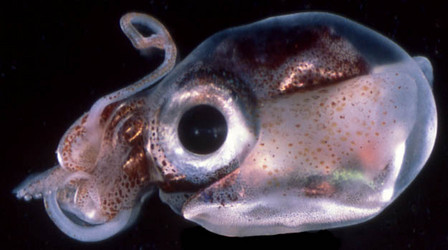

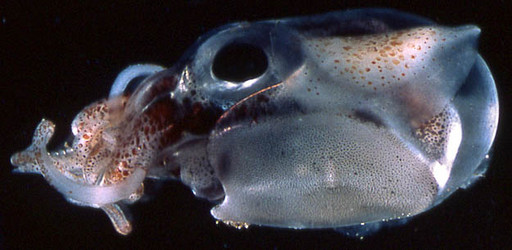
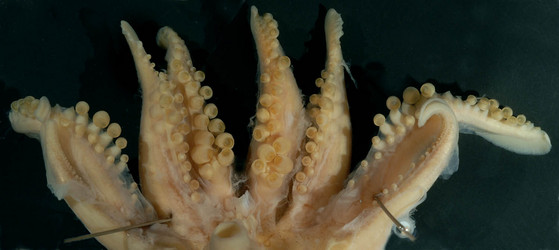
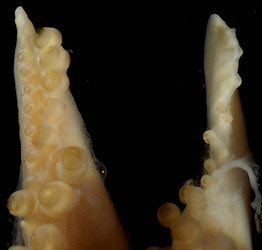

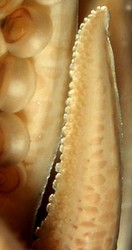



 Go to quick links
Go to quick search
Go to navigation for this section of the ToL site
Go to detailed links for the ToL site
Go to quick links
Go to quick search
Go to navigation for this section of the ToL site
Go to detailed links for the ToL site